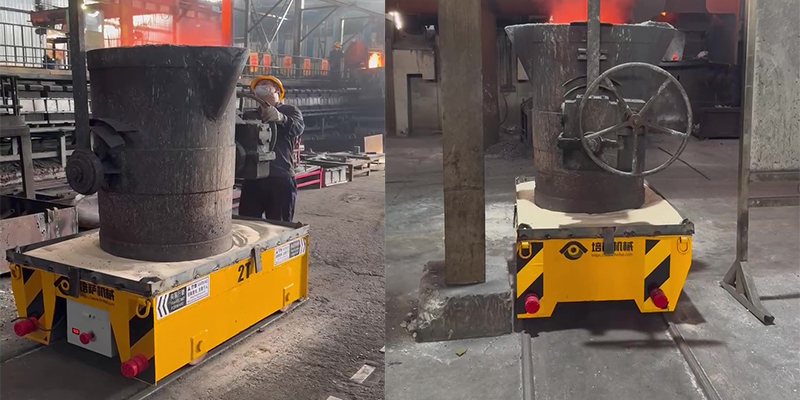Electric Flat Carts in the Iron and Steel Metallurgical Industry
In the vast and complex system of metallurgy and the steel industry, electric flat carts play an indispensable role by providing stable and efficient material transfer services for many processes, such as those in steel mills, aluminum plants, and copper material processing. Among them, the ladle transfer cart as a typical representative of electric flat carts in the smelting industry, plays a key role in the process from raw material transportation to finished product output.
1. Classification and Use of Ladle Transfer Carts
Ladle transfer carts are primarily divided into molten iron transfer carts, slag transfer carts, and ingot transfer carts, based on the characteristics of the materials they carry and the differences in production processes. Each type of transfer cart has its specific duties, ensuring the smooth progress of metallurgical production.
The molten iron transfer cart, the most common type of ladle cart, is responsible for transporting high-temperature liquid iron. As a key raw material for steelmaking, the safety and stability of molten iron transportation are crucial.
Steel mills of different sizes select ladle carts of varying tonnages based on their production capacity and process requirements. Common smaller ladle transfer carts of 5 tons and 20 tons are typically used in small steelmaking workshops or specific refined production processes. These carts are agile, capable of maneuvering in relatively narrow spaces and accurately transporting molten iron to key equipment such as converters.

For large steel mills, ladle carts with capacities of 90 tons, 100 tons, or even larger have become the primary choice. These heavy-duty carts can carry substantial amounts of molten iron at once, meeting the material turnover needs of large-scale, high-efficiency steelmaking, and significantly improving production efficiency.
The slag transfer cart is another vital transportation tool in the steel smelting industry. A large amount of waste slag is generated during the steelmaking process. This slag needs to be cleaned up and transported to designated areas for subsequent treatment. Thanks to its robust structure and excellent heat resistance, the slag transfer cart can safely carry high-temperature slag blocks away from the steelmaking site. This prevents the accumulation of waste slag, which could otherwise hinder production, and also facilitates the environmentally friendly disposal of slag.
The ingot transfer cart is used to transport cast ingots to subsequent processing stages. Whether the ingots are to be rolled, forged, or stored, this cart is indispensable. It ensures the smooth transition of ingots between various processes, prevents damage to their surfaces, and guarantees the quality of the finished steel products.

2. Adaptation Design for Ladles of Different Tonnages
Ladles are the core containers carried by ladle transfer carts, and the adaptation design of these ladles and the carts is directly related to the safety and efficiency of transportation.
For smaller-tonnage ladles, especially those with round bases, a practical and economical solution is to lay refractory bricks on the ladle transfer cart platform.
These bricks effectively resist the high-temperature erosion of molten iron, preventing the cart table from becoming deformed or damaged due to prolonged heating. The refractory bricks also act as a buffer, reducing the shaking of ladles during transportation, ensuring smooth movement of molten iron, and meeting the basic transportation needs of daily production.
However, when dealing with large-tonnage ladles, the situation is more complex. Simply relying on refractory bricks is not enough to ensure transportation safety. In these cases, custom brackets designed to secure the ladle are necessary. These brackets are typically engineered to match the shape, size, and center of gravity distribution of the molten iron ladle, and are made from high-strength, heat-resistant alloy materials. On one hand, the brackets firmly secure the molten iron ladle on the cart, maintaining stability during high-speed transportation and turns, thereby eliminating the risk of molten iron splashing. On the other hand, the reasonable design of the brackets ensures that the weight of the molten iron ladle is evenly distributed across the load-bearing parts of the cart, preventing localized overloads, reducing the risk of vehicle damage, and extending the service life of the ladle transfer cart.

3. Drive Design and Safety Considerations of High-Tonnage Ladle Transfer Carts
With the continuous development of the metallurgical industry, the scale of production is expanding, and the demands for ladle transfer carts with higher load capacities are growing. When the load of the ladle cart exceeds 120 tons, the design of its drive system becomes a critical factor. To ensure safety, a dual-drive design is a common practice in the industry.
A dual-drive system means that the ladle transfer cart is equipped with two independent power drive units that work together to provide strong driving force. Under normal operation, these systems intelligently distribute power based on factors such as vehicle load and driving conditions, achieving efficient and smooth operation.
In case of system failure, such as motor burnout or transmission component damage, the backup system can quickly take over all power output. This ensures that the cart can continue to operate at a lower speed, preventing the interruption of molten iron transportation and avoiding serious production accidents, such as molten iron solidifying in the cart. This design maximizes production continuity and ensures both personnel and equipment safety.
In the design and manufacturing process, PEISA Machinery takes great care to meet high safety standards. From strictly screening raw materials to ensure the strength, heat resistance, and corrosion resistance of each component, to using precise processing technology to guarantee the dimensional accuracy and assembly quality of every part, the company works to eliminate any potential safety hazards caused by manufacturing defects. Comprehensive testing is conducted to simulate extreme working conditions, repeatedly verifying the load capacity, driving performance, braking effectiveness, and heat resistance stability of the ladle transfer cart. Only products that pass rigorous testing are delivered to steel mills and put into the critical metallurgical production process.
Electric flat carts in the metallurgical steel industry, particularly ladle transfer carts, are essential. Whether in a small local steel mill or a large steel conglomerate, choosing an electric flat cart that meets production needs is key to ensuring efficient and stable production. If you encounter challenges with ladle transportation, please contact us, and we will provide you with a free design solution.


Message Board